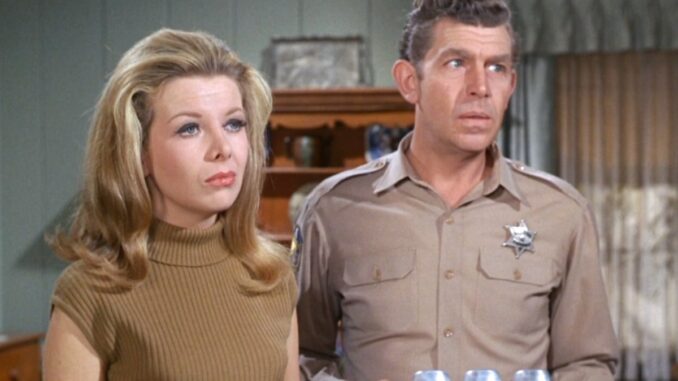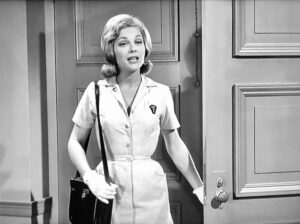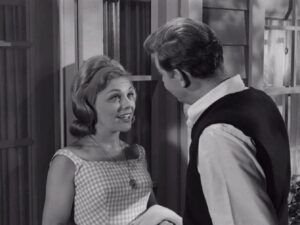
Television in the 1960s was a reflection of the cultural norms of the time. Women were often depicted wearing skirts or dresses, especially in family-oriented shows like The Andy Griffith Show. But did you know that one bold character broke away from this mold and became the first woman on the series to wear pants? Yes, Andy’s girlfriend, who dared to challenge the status quo, sparked a quiet yet impactful fashion revolution on the small screen.
In this article, we’ll take a closer look at the significance of this wardrobe choice, how it resonated with the audience, and what it meant for women on television moving forward. Let’s dive in!
A Cultural Shift on ‘The Andy Griffith Show’
The Andy Griffith Show was a slice-of-life comedy set in the small town of Mayberry, North Carolina. With its focus on wholesome values and light-hearted humor, the series reflected 1960s family life in America. However, behind the seemingly innocent scenes, a subtle but significant cultural shift was happening, and it was sparked by Andy’s girlfriend.
Who Was Andy’s Girlfriend on ‘The Andy Griffith Show’?

Andy Taylor, the show’s protagonist, had a few romantic interests throughout the series, but one girlfriend, in particular, stood out. This was Ellie Walker, portrayed by actress Elinor Donahue. Ellie was a strong, independent character who worked as a pharmacist. She was not only Andy’s love interest but also a symbol of women breaking away from traditional roles.
Breaking the Norm: Ellie’s Bold Fashion Choice
In an era when television showed women almost exclusively in dresses or skirts, Ellie’s decision to wear pants on The Andy Griffith Show was a bold move. It may seem like a small detail today, but back then, it was a radical departure from the norm. Pants were associated with men, and women on TV were rarely seen breaking this gendered fashion code.
Why Was This So Significant?
In the 1960s, women’s fashion was strictly divided by gender. Dresses were the standard for women on television and in real life. By having Ellie wear pants, the show challenged traditional gender roles. It wasn’t just about fashion—it was a statement about women’s evolving roles in society.
The Audience Reaction to Ellie’s Pants
Interestingly, Ellie’s pants did not cause the kind of uproar you might expect. In fact, many viewers appreciated her character’s forward-thinking fashion sense. It resonated with a generation of women who were beginning to see changes in societal expectations, and it helped normalize the idea of women wearing pants in everyday life.
The Influence of Television on Fashion Trends
Television has always played a role in shaping fashion trends. When popular characters on TV shows embrace new styles, the audience takes notice. Ellie Walker’s pants were no different. After this groundbreaking moment, more women in real life and on TV began to embrace trousers as a regular part of their wardrobe. What was once considered unconventional quickly became mainstream.
A Shift Toward Empowerment
Ellie’s wardrobe choice on The Andy Griffith Show was more than just a fashion statement—it was a reflection of the slow but steady shift toward women’s empowerment in the 1960s. Women were starting to enter the workforce in greater numbers and challenge the traditional norms that had confined them to domestic roles. Ellie’s character, both as a working professional and as someone who dressed for practicality and comfort, embodied these changes.
Television’s Impact on Gender Roles

The Andy Griffith Show was part of a larger conversation happening in America at the time. As gender roles began to evolve, so too did the way women were portrayed on television. The inclusion of Ellie in pants was a subtle yet impactful nod to this societal shift, showing that women could be both feminine and independent, stylish and practical.
Ellie Walker’s Legacy on TV
Ellie Walker was a trailblazer for women on television. After her, other female characters began to challenge the norms by wearing pants or taking on more independent, non-traditional roles. Shows like The Mary Tyler Moore Show and I Love Lucy later featured strong women who were not afraid to defy expectations, following in Ellie’s footsteps.
Fashion and Feminism: The Connection
The decision for a woman to wear pants on television in the 1960s may seem like a small step, but it was tied to a much larger movement—feminism. Women were demanding equal rights in various spheres of life, including the right to wear what they wanted. Ellie’s wardrobe choice was part of this ongoing conversation about women’s freedom and equality.
How Fashion Has Evolved on TV Since the 1960s
Fast forward to today, and the evolution of fashion on television is clear. Women are no longer limited to specific gendered clothing, and they have the freedom to express their individuality in any way they choose. From power suits to casual jeans, the diversity in women’s fashion on TV reflects the broader shifts in society.
The Subtle Power of Television
Television has the power to influence society in ways that are sometimes difficult to quantify. Ellie Walker’s pants may not have been a headline-grabbing moment, but it quietly helped shift perceptions about women’s fashion and roles. Through small acts like this, TV shows can contribute to larger societal changes, reflecting and sometimes even accelerating cultural evolution.
The Importance of Challenging Norms
By challenging norms—whether through fashion, behavior, or attitudes—television characters like Ellie Walker play an essential role in pushing society forward. Sometimes, it’s the small acts of rebellion that make the biggest difference, and Ellie’s pants were a perfect example of this.
The Enduring Legacy of ‘The Andy Griffith Show’
Even though The Andy Griffith Show aired decades ago, its cultural impact is still felt today. From its humorous take on small-town life to its subtle challenge of societal norms, the show remains a beloved part of television history. And thanks to characters like Ellie Walker, it also played a small but important role in advancing the conversation about women’s roles in society.
Conclusion
Ellie Walker’s decision to wear pants on The Andy Griffith Show might seem like a small detail, but it was a bold statement in its time. It reflected the shifting attitudes toward gender roles and women’s fashion in the 1960s, paving the way for future generations of women on television. This moment of rebellion against the traditional norms helped normalize the idea that women could dress as they pleased, signaling a broader societal change.
